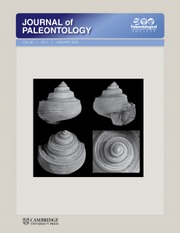Crossref Citations
This article has been cited by the following publications. This list is generated based on data provided by
Crossref.
Giles, Sam
and
Friedman, Matt
2014.
Virtual reconstruction of endocast anatomy in early ray-finned fishes (Osteichthyes, Actinopterygii).
Journal of Paleontology,
Vol. 88,
Issue. 4,
p.
636.
Lautenschlager, Stephan
and
Rücklin, Martin
2014.
Beyond the print—virtual paleontology in science publishing, outreach, and education.
Journal of Paleontology,
Vol. 88,
Issue. 4,
p.
727.
Jones, Fiona M.
Dunlop, Jason A.
Friedman, Matt
and
Garwood, Russell J.
2014.
Trigonotarbus johnsoni Pocock, 1911, revealed by X-ray computed tomography, with a cladistic analysis of the extinct trigonotarbid arachnids.
Zoological Journal of the Linnean Society,
Vol. 172,
Issue. 1,
p.
49.
Rahman, Imran A.
and
Smith, Selena Y.
2014.
Virtual paleontology: computer-aided analysis of fossil form and function.
Journal of Paleontology,
Vol. 88,
Issue. 4,
p.
633.
Garwood, Russell J.
and
Dunlop, Jason
2014.
Three-dimensional reconstruction and the phylogeny of extinct chelicerate orders.
PeerJ,
Vol. 2,
Issue. ,
p.
e641.
Steart, David C.
Spencer, Alan R.T.
Garwood, Russell J.
Hilton, Jason
Munt, Martin C.
Needham, John
and
Kenrick, Paul
2014.
X-ray Synchrotron Microtomography of a silicified Jurassic Cheirolepidiaceae (Conifer) cone: histology and morphology ofPararaucaria collinsonaesp. nov..
PeerJ,
Vol. 2,
Issue. ,
p.
e624.
Giles, Sam
Coates, Michael I.
Garwood, Russell J.
Brazeau, Martin D.
Atwood, Robert
Johanson, Zerina
Friedman, Matt
and
Ruta, Marcello
2015.
Endoskeletal structure inCheirolepis(Osteichthyes,Actinopterygii), An early ray‐finned fish.
Palaeontology,
Vol. 58,
Issue. 5,
p.
849.
Lautenschlager, Stephan
2015.
Estimating cranial musculoskeletal constraints in theropod dinosaurs.
Royal Society Open Science,
Vol. 2,
Issue. 11,
p.
150495.
Spencer, Alan R. T.
Mapes, Gene
Bateman, Richard M.
Hilton, Jason
and
Rothwell, Gar W.
2015.
Middle Jurassic evidence for the origin of Cupressaceae: A paleobotanical context for the roles of regulatory genetics and development in the evolution of conifer seed cones.
American Journal of Botany,
Vol. 102,
Issue. 6,
p.
942.
Giles, Sam
Darras, Laurent
Clément, Gaël
Blieck, Alain
and
Friedman, Matt
2015.
An exceptionally preserved Late Devonian actinopterygian provides a new model for primitive cranial anatomy in ray-finned fishes.
Proceedings of the Royal Society B: Biological Sciences,
Vol. 282,
Issue. 1816,
p.
20151485.
Weihmann, Tom
Goetzke, Hanns Hagen
and
Günther, Michael
2015.
Requirements and limits of anatomy-based predictions of locomotion in terrestrial arthropods with emphasis on arachnids.
Journal of Paleontology,
Vol. 89,
Issue. 6,
p.
980.
Rahman, Imran A.
and
Lautenschlager, Stephan
2016.
APPLICATIONS OF THREE-DIMENSIONAL BOX MODELING TO PALEONTOLOGICAL FUNCTIONAL ANALYSIS.
The Paleontological Society Papers,
Vol. 22,
Issue. ,
p.
119.
de Bakker, Bernadette S.
de Jong, Kees H.
Hagoort, Jaco
de Bree, Karel
Besselink, Clara T.
de Kanter, Froukje E. C.
Veldhuis, Tyas
Bais, Babette
Schildmeijer, Reggie
Ruijter, Jan M.
Oostra, Roelof-Jan
Christoffels, Vincent M.
and
Moorman, Antoon F. M.
2016.
An interactive three-dimensional digital atlas and quantitative database of human development.
Science,
Vol. 354,
Issue. 6315,
Selden, Paul A.
Dunlop, Jason A.
and
Garwood, Russell J.
2016.
Carboniferous araneomorph spiders reinterpreted as long-bodied harvestmen.
Journal of Systematic Palaeontology,
Vol. 14,
Issue. 2,
p.
127.
Garwood, Russell J.
Edgecombe, Gregory D.
Charbonnier, Sylvain
Chabard, Dominique
Sotty, Daniel
and
Giribet, Gonzalo
2016.
Carboniferous Onychophora from Montceau‐les‐Mines, France, and onychophoran terrestrialization.
Invertebrate Biology,
Vol. 135,
Issue. 3,
p.
179.
Lautenschlager, Stephan
2016.
DIGITAL RECONSTRUCTION OF SOFT-TISSUE STRUCTURES IN FOSSILS.
The Paleontological Society Papers,
Vol. 22,
Issue. ,
p.
101.
Garwood, Russell J.
Dunlop, Jason A.
Selden, Paul A.
Spencer, Alan R. T.
Atwood, Robert C.
Vo, Nghia T.
and
Drakopoulos, Michael
2016.
Almost a spider: a 305-million-year-old fossil arachnid and spider origins.
Proceedings of the Royal Society B: Biological Sciences,
Vol. 283,
Issue. 1827,
p.
20160125.
Parry, Luke A.
Boggiani, Paulo C.
Condon, Daniel J.
Garwood, Russell J.
Leme, Juliana de M.
McIlroy, Duncan
Brasier, Martin D.
Trindade, Ricardo
Campanha, Ginaldo A. C.
Pacheco, Mírian L. A. F.
Diniz, Cleber Q. C.
and
Liu, Alexander G.
2017.
Ichnological evidence for meiofaunal bilaterians from the terminal Ediacaran and earliest Cambrian of Brazil.
Nature Ecology & Evolution,
Vol. 1,
Issue. 10,
p.
1455.
Brasier, A. T.
Cotton, L. J.
Garwood, R. J.
Baker-Brian, J.
Howlett, E.
and
Brasier, M. D.
2017.
Earliest Cretaceous cocoons or plant seed structures from the Wealden Group, Hastings, UK.
Geological Society, London, Special Publications,
Vol. 448,
Issue. 1,
p.
399.
Brasier, Martin D.
Norman, David B.
Liu, Alexander G.
Cotton, Laura J.
Hiscocks, Jamie E. H.
Garwood, Russell J.
Antcliffe, Jonathan B.
and
Wacey, David
2017.
Remarkable preservation of brain tissues in an Early Cretaceous iguanodontian dinosaur.
Geological Society, London, Special Publications,
Vol. 448,
Issue. 1,
p.
383.

